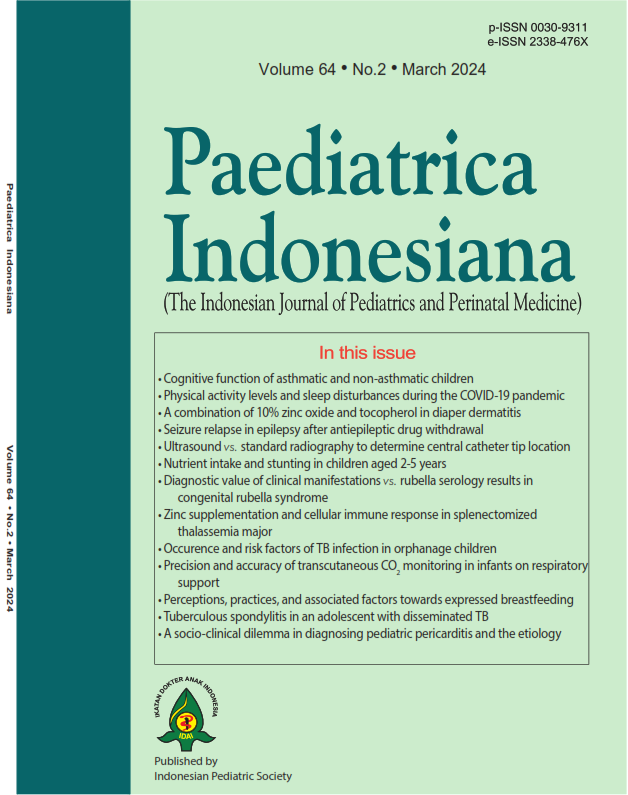Ultrasound vs. standard radiography to determine peripherally-inserted central catheter tip location
Abstract
Background The use of a peripherally-inserted central catheter (PICC) has increased in preterm neonates to facilitate the administration of total parenteral nutrition. Standard radiography (thoracoabdominal X-ray) is the gold standard for determining the position of the PICC tip. However, radiography is not always accurate, influenced by the position of the extremities and anatomic variations, time-consuming procedural process, involves radiation, and is costly. Ultrasonography (USG) may serve as an easier, safer, less costly, and more real-time alternative in the neonatal intensive care unit (NICU) patients.
Objective To assess the accuracy of USG use in determining PICC tip position compared to that of standard radiography.
Methods This diagnostic study was conducted in the NICU at Dr. Cipto Mangunkusumo Hospital, Jakarta. The PICCs were placed using standard NICU procedure, then the tip position was evaluated using the USG immediately before standard radiography was performed. A 2x2 table was constructed to compare the diagnostic accuracy of the two modalities.
Results A total of 29 neonates were included in our study. Subjects’ mean gestational age and weight were 31.7 weeks and 1,618.9 g respectively. Concordance of PICC tip positioning between standard radiography and USG occurred in 27 neonates (93.1%). USG had 88.89% sensitivity, 95% specificity, and 93.1% diagnostic accuracy.
Conclusion USG has excellent diagnostic accuracy for confirmation of the PICC tip position.
References
2. Harling E, Connolly G. Diagnostic and therapeutic procedures. In: Boxwell G, editor. Neonatal intensive care nursing. 2nd ed. New York: Routledge; 2010. p. 329-62.
3. Ringer SA, Gray JE. Common neonatal procedures. In: Cloherty JP, Eichenwald EC, Hansen AR, Stark AR, editors. Manual of neonatal care. 7th ed. Philadelphia: Lippincott Williams & Wilkins; 2012. p. 851-69.
4. Katheria AC, Fleming SE, Kim JH. A randomized controlled trial of ultrasound-guided peripherally inserted central catheters compared with standard radiographs in neonates. J Perinatol. 2013;33:791-4. DOI: https://doi.org/10.1038/jp.2013.58.
5. Tauzin L, Sigur N, Joubert C, Parra J, Hassid S, Moulies ME. Echocardiography allows more accurate placement of peripherally inserted central catheters in low birthweight neonates. Acta Paediatr. 2013;102:703-6. DOI: https://doi.org/10.1111/apa.12245
6. de Camargo PP, Kimura AF, Toma E, Tsunechiro MA. Initial peripherally inserted central catheter tip position in neonates. Rev Esc Enferm USP. 2008;42:719-24. DOI: https://doi.org/10.1590/s0080-62342008000400015.
7. Hoang V, Sills J, Chandler M, Busalani E, Clifton-Koeppel R, Modanlou HD. Percutaneously inserted central catheter for total parenteral nutrition in neonates: complications rates related to upper versus lower extremity insertion. Pediatrics. 2008;121:e1152-9. DOI: https://doi.org/10.1542/peds.2007-1962.
8. Nowlen TT, Rosenthal GL, Johnson GL, Tom DJ, Vargo TA. Pericardial effusion and tamponade in neonates with central catheters. Pediatrics. 2002;110:137-42. DOI: https://doi.org/10.1542/peds.110.1.137.
9. Garber SJ, Puopolo KM. Prevention of central line-associated bloodstream infections among neonates in the neonatal intensive care unit. Neoreviews. 2015;16:e211-20. DOI: https://doi.org/10.1542/neo.16-4-e211.
10. Nadroo AM, Glass RB, Lin J, Green RS, Holzman IR. Changes in upper extremity position cause migration of peripherally inserted central catheters in neonates. Pediatrics. 2002;110:131-6. DOI: https://doi.org/10.1542/peds.110.1.131.
11. Jain A, Deshpande P, Shah P. Peripherally inserted central catheter tip position and risk of associated complications in neonates. J Perinatol. 2013;33:307-12. DOI: https://doi.org/10.1038/jp.2012.112.
12. Colacchio K, Deng Y, Northrup V, Bizzarro MJ. Complications associated with central and non-central venous catheters in a neonatal intensive care unit. J Perinatol. 2012;32:941-6. DOI: https://doi.org/10.1038/jp.2012.7
13. Fleming SE, Kim JH. Ultrasound- guided umbilical catheter insertion in neonates. J Perinatol. 2011;31:344-9. DOI: https://doi.org/10.1038/jp.2010.128.
14. Kuschel CA, Bach KP, Webster NJ, Page B, Groves AM, Battin MR. The reliability of 2D and colour Doppler ultrasound in localizing longline position. J Pediatrics Child Health. 2008;44:483-7. DOI: https://doi.org/10.1111/j.1440-1754.2008.01333.x.
15. Evans N, Gournay V, Cabanas F, Kluckow M, Leone T, Groves A, et al. Point-of-care ultrasound in the neonatal intensive care unit: international perspectives. Semin Fetal Neonatal Med. 2011;16:61-8. DOI: https://doi.org/10.1016/j.siny.2010.06.005.
16. Pettit J, Wyckoff MM. Peripherally inserted central catheters guidelines for practice. 2nd Edition. Glenview:National Association of Neonatal Nurses. 2007.
17. Ohki Y, Tabata M, Kuwashima M, Takeuchi H, Nako Y, Morikawa A. Ultrasonographic detection of very thin percutaneous central venous catheter in neonates. Acta Paediatr. 2000;89:1381- 4. DOI: https://doi.org/10.1080/080352500300002615.
18. Jain A, McNamara PJ, Ng E, El- Khuffash A. The use of targeted neonatal echocardiography to confirm placement of peripherally inserted central catheters in neonates. Am J Perinatol. 2012;29:101-6. DOI: https://doi.org/10.1055/s-0031-1295649.
19. Tauzin L, Sigur N, Joubert C, Parra J, Hassid S, Moulies ME. Echocardiography allows more accurate placement of peripherally inserted central catheters in low birthweight neonates. Acta Paediatr. 2013;102:703-6. DOI: https://doi.org/10.1111/apa.12245.
20. Nadroo AM, Glass RB, Lin J, Green RS, Holzman IR. Changes in upper extremity position cause migration of peripherally inserted central catheters in neonates. Pediatrics. 2002;110:131-6. DOI: https://doi.org/10.1542/peds.110.1.131.
21. Nowlen TT, Rosenthal GL, Johnson GL, Tom DJ, Vargo TA. Pericardial effusion and tamponade in neonates with central catheters. Pediatrics. 2002;110:137-42. DOI: https://doi.org/10.1542/peds.110.1.137.
Copyright (c) 2024 James Thimoty

This work is licensed under a Creative Commons Attribution-NonCommercial-ShareAlike 4.0 International License.
Authors who publish with this journal agree to the following terms:
Authors retain copyright and grant the journal right of first publication with the work simultaneously licensed under a Creative Commons Attribution License that allows others to share the work with an acknowledgement of the work's authorship and initial publication in this journal.
Authors are able to enter into separate, additional contractual arrangements for the non-exclusive distribution of the journal's published version of the work (e.g., post it to an institutional repository or publish it in a book), with an acknowledgement of its initial publication in this journal.
Accepted 2024-04-24
Published 2024-04-24













